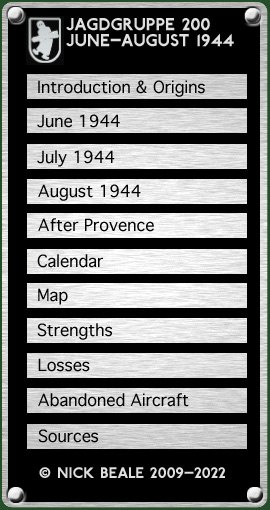|
The imminence of Allied landings brought the diversion of 12th Air Force units from Italian to French targets and so JGr. 200 found itself in action against tactical bombers. The Gruppe's first operation of the 6th was a scramble by ten Bf 109s to intercept a formation of B-25s of the 310th BG which were attacking the bridge at Avignon. While part of the German formation reported combat with escorting fighters, three Messerschmitts got through to the Mitchells. As described by the diarist of the 379th BS: "Twelve of our ships took part in the first group mission against a target in France. The bridge at Avignon was hit. Fried chicken for dinner; a great treat. With fresh potatoes too. On today's mission the formation was attacked by enemy fighters, the first time in a long while that our planes had encountered aerial oppostion. However [they] made only a few ineffective passes." It looked rather different from the 381st Bomb Squadron's rear flight, as 1/Lt. O.L.J. Twedt related: "This, my 43rd combat mission, was different. It was to be my first mission as first pilot, and the crew … were to experience their first taste of combat. Furthermore, in the briefing we learned that the target was defended by 6 heavy flak batteries and that previous missions in the vicinity had been intercepted by enemy fighters … … as we levelled out for our bomb run there was a puff close the left wing, followed by a thumping sound. It had caught our port gas tank, and the fuel started to run out. The plane lurched upward, as [Bombardier] Lt. Smith's voice over the interphone announced that bombs were away … a climbing left turn … soon brought us out of range of the flak … Our gas tank sealed itself and was no longer leaking. So far so good. But then … a radio message from Lt. McDonald's aircraft … instructed us to move out of formation, as his port engine had been hit and he was feathering his prop. In the meanwhile, the 2nd element had fallen back. Lt. Larkin, its element leader, was also on a single engine. Lt. Eichten had taken over the controls, and I had pushed back the seat for a cigarette, when two single engined aircraft appeared alongside. They were rocking their wings and looked remarkably like P-51's, but Cpl. Paolini, the turret gunner, was not fooled by their maneuvers. When the two fighters turned and attacked from 9 o'clock, he opened fire as soon as they had turned their noses toward us. His fire was accurate, for as one of the ME-109's passed above us it was smoking. But during the attack a 20 mm. shell had hit by my window, slashed the front of my Mae West. Two pieces crossed and struck Lt. Eichten. The shock caused him to lose consciousness, and for an instant the plane was out of control. Lt. Smith crawled up from the nose to render first aid to Lt. Eichten … the wounds which he had received in his left hip and wrist were very serious. He was losing blood rapidly." After a hair-raising emergency landing on the short runway at Calvi, Corsica, Eichten was taken to hospital. No claims appear to have been made on either side but at 09.32 hours (local time) Allied Signals Intelligence heard a fighter force-landing at base with engine trouble. The day's target for the B-26s of the 320th BG was the Tarascon railway bridge. Making landfall at around 09.50, they reported an unidentified single-engined aircraft "above and behind their formation at 15,000 feet." It was reported as firing rockets but no bursts were observed inside the B-26 formation. In the second operation, six Bf 109s achieved visual contact with Liberators and reported combat with escorting Mustangs (who, if MASAF's daily summary is any guide, appear not to have noticed it). Another eight sorties were flown during the day, one Schwarm taking off from Aix les Milles at 18.22 and a second at 19.05 hours. During the bomb run of the 320th BG's second trip to Tarascon, a Bf 109 was seen to the right of the formation and was chased off by escorting P-47s while a second German fighter behind the bombers was also driven away. The first of these sightings was timed at 18.05 hours, which does not correspond with periods when German fighters are supposed to have been in the air. The 14th FG bombed the airfields at Orange Plan de Dieu and Valence, claiming the destruction of two aircraft on the ground at the former and five destroyed and three probables at the latter. One of the Group's P-38s was lost to Flak during the Orange attack (2/Lt. Robert D. Simpson) and four from the escorting 1st FG crashlanded after the mission. The Germans claimed two P-38s shot down and reported "no damage"at Plan de Dieu. Aix-Les Milles was shot up by Thunderbolts which slightly damaged a Bf 109 and wounded one man. A supplementary report next day said that an attack on Les Milles by a single P-47 had left a Bf 109 on fire. Ground personnel of 3./JGr. 200 claimed to have shot one of the P-47s down. Guy julien has identified this as the aircraft of Lt De Chanterac of GC 2/3 "Dauphiné" who bailed out and was taken prisoner. continued on next page …
|
|||

